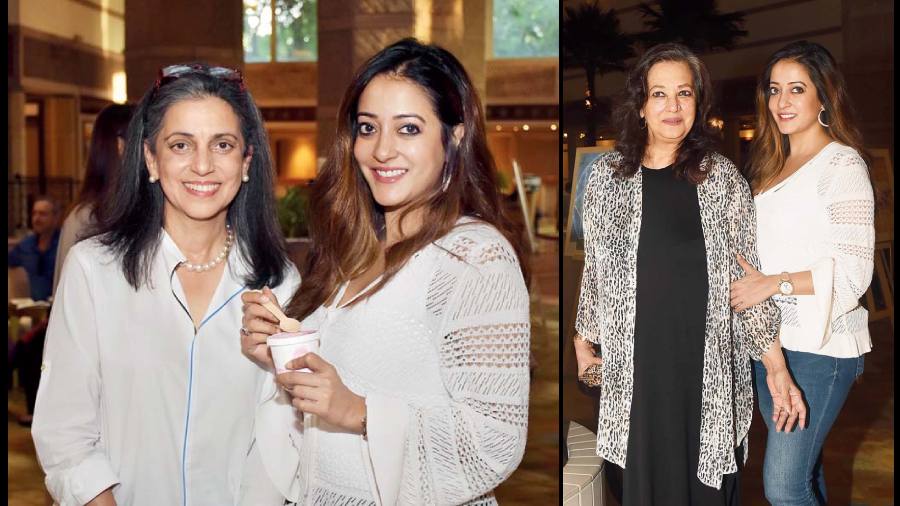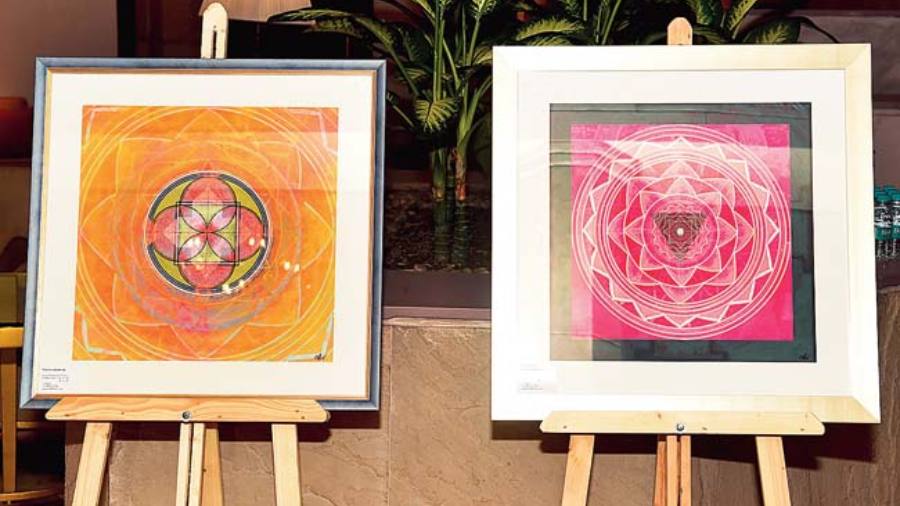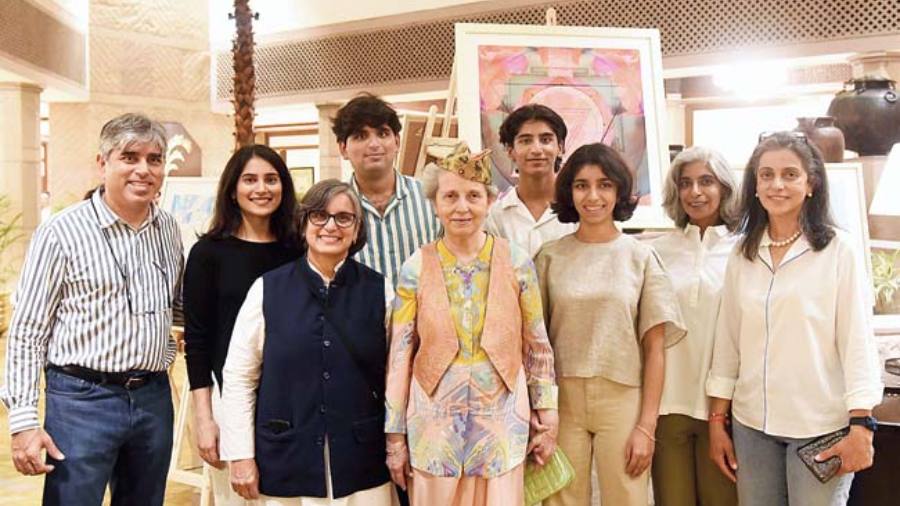The exhibits titled ‘Lines of the Divine’ at the Taj Bengal lounge drew an eclectic mix of viewers, many of them struck by the immediate pull of the vibrant art, and the others, the buyers, drawn by the symbolism of deification through a unique set of multilayered multi-sensory artistry. Each of them felt a different “need”, some seeking the meditative calm that these artistic pieces exude, others going for a depiction of their known deities, in abstraction, and encountering divine vibes.
For me, the whole experience needed a reaffirmation from the artist herself, Gita Pandit, photographer, singer, poet, who, in a collaboration of coalesced energies with Poonam Ahuja, has given a fresh dimension to art.
Poonam brings to the table her scholarship of ancient texts of Hinduism, mysticism and esoteric thought. She applies her knowledge and understanding to make for harmonious solutions to well-being in life. Each of the art pieces has detailed referencing to the scriptures, which give depth and dimension and understanding of the innate philosophies underlying the art. Gita is the photographer with her own deep spiritual bent and her special interests in the mysteries of the mystic. Growing up in a multicultural atmosphere, art surrounded her. M.F. Husain was a long-time friend of the family and a big influence on her art, and at one stage encouraged her to do some larger-than-lifesize photographs for his film Meenaxi: A Tale of Three Cities, which were displayed as installations to promote the film in Europe and India.

Gita Kumar Pandit with Rita Bhimani. Pictures: B. Halder
To comprehend this particular art form, it was imperative to understand a deeper spiritual journey that both have undertaken, trawling the length and breadth of India’s Shakti peeths. The actual process of their creations starts with Poonam putting pen to paper for “sacred geometry”. When the two of them decided to collaborate, just about a decade ago, the methodology was based on Poonam’s research of numerology and astrology with sacred geometry, which, Gita explains, gives life its harmony, balance, depth.
Poonam talks of the drawings being the base of the art, which happened using pure geometry in just the same manner as it is used in the design of sacred spaces such as temples, mosques and churches. Adding: “As the journeys to sacred sites happened, the energy vibrations of these spaces would take one onto a much deeper level. Sometimes, the sacred geometry drawings would be the guiding light, pointing us in the direction of a spiritual site. At other times, the sacred sites would invoke a desire to create certain sacred geometric forms soon after experiencing the energy vibrations of that space.”
Thus it was that she and Gita sallied forth to on the first leg of their Shakti peeths, (26 of the 51 visited so far!) in Odisha. Driving for hundreds of miles to the temple of Lord Jagannath, to discover Taratarini Devi, the Buddhist sites of Ratnagiri, Udayagiri and Lalitgiri and the Ma Kali temple in Bhubaneswar.

Raima Sen enjoyed some Minus Thirty gelato, that is supporting the do, with Preah by her side. The ice cream brand is the brainchild of Preah’s daughters Shivanie Mirchandani and Gayatri Rattha. ; Moon Moon Sen and Raima Sen at the exhibition
So, the art that we observe starts with sacred geometry, and then Gita takes over with her photography of the site, the deities, the surroundings, capturing it all in camera lens and mind’s eye, to create layer after layer of photographic images, digitally, to finally come to the end product in a spatial unity of colours, shapes, and spiritual sagacity.
It is the colour palette that draws you to look and interface with the art. A lot of it mystified me, as one had certain preconceptions of what a deity could stand for. Goddess Kali should be blood red, right? Wrong, in Gita and Poonam’s lexicon. Their magnificent Mahakali appears in shades of pink, magenta, olive as a meditative work of a sacred drawing of the Kali Yantra. But where is Ma Kali’s tongue? Remarkably, a sprinkling of gentle photographs of flowers to depict it. The Goddess is all-loving, says Gita and you should not fear Mahakali.
Then there is their foray into the Kamakhya temple in Assam, one of the oldest and most powerful of the Shakti peeths. Once more, we look for a preconceived crimson that we associate with Kamakhya, the Tantric temple. Why the yellow depiction then? The artwork is a geometric symbol of the goddess Baglamukhi, one of the 10 forms of Dasa Mahavidya. Goddess Baglamukhi’s association with Kamakhya enhances the power of her energies. Gita calls this artwork the Yellow Goddess, where the energies of the two Goddesses have merged. Yellow is the colour of joy.

Glimpses of ‘Lines of the Divine’
From golden tones, we focus on several images of Bodhisattva Kuan Yin, seated in lotus position, in various shades — one with a green light relating to youth, nature, balance and harmony, another indicating balance of thought, tranquillity and attainment of spiritual perfection.
Two powerful depictions of Shiva Lingam from the Ekambareswarar temple in Kanchipuram, gaining strength from the blue of Shiva’s throat, contrast with a muted blue geometric drawing with the superimposition of the entrance to the Matrubhuteswara temple in Tiruvannamalai. The flowering of the Bindu unfolds, beginning the story of creation.
And back to the reverential red of Tripura Sundari, her yantra the Sri Chakra, being the transformative symbol in life.
A unique meld of form and spirituality, the cosmic consciousness and the energy vibrations of these spaces are a voyage of discovery and the uncovering of layered religious allusion that illusorily takes you into the depths of a sacred geometric depiction of religious icons through visual symbols.
The exhibition is on at Taj Bengal’s Palm Lounge, 24x7, till September 4
